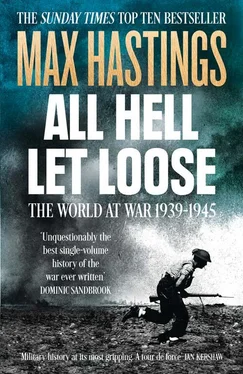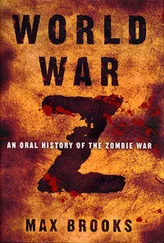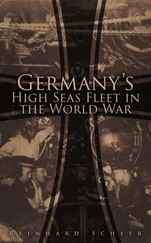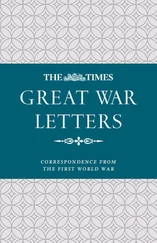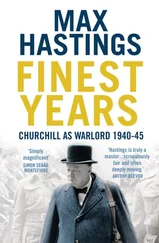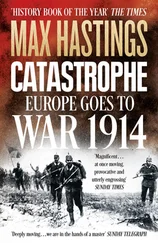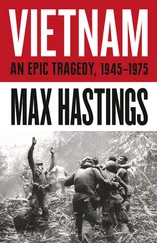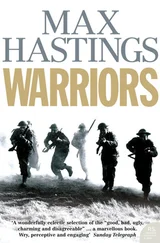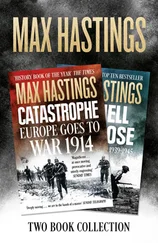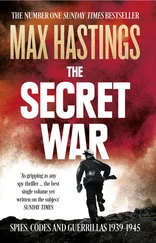Max Hastings
All Hell Let Loose
The World at War 1939–45

WilliamCollins
An imprint of HarperCollinsPublishers Ltd.
1 London Bridge Street
London SE1 9GF
www.WilliamCollinsBooks.co.uk
First published in Great Britain by HarperPress in 2011
ALL HELL LET LOOSE. Copyright © Max Hastings 2011. All rights reserved under International and Pan-American Copyright Conventions. By payment of the required fees, you have been granted the nonexclusive, nontransferable right to access and read the text of this e-book on-screen. No part of this text may be reproduced, transmitted, downloaded, decompiled, reverse-engineered, or stored in or introduced into any information storage and retrieval system, in any form or by any means, whether electronic or mechanical, now known or hereinafter invented, without the express written permission of HarperCollins e-books.
Max Hastings asserts the moral right to be identified as the author of this work
A catalogue record for this book
is available from the British Library
HarperCollins Publishers has made every reasonable effort to ensure that any picture content and written content in this ebook has been included or removed in accordance with the contractual and technological constraints in operation at the time of publication
Source ISBN: 9780007338092
Ebook Edition © AUGUST 2011 ISBN: 9780007338122
Version: 2018-07-17
TO MICHAEL SISSONS,
for thirty years a princely agent,
counsellor and friend
Cover
Title Page
Copyright
Dedication
List of Maps
Introduction
1 Poland Betrayed
2 No Peace, Little War
3 Blitzkriegs in the West
1
Norway
2
The Fall of France
4 Britain Alone
5 The Mediterranean
1 Mussolini Gambles
2 A Greek Tragedy
3 Sandstorms
6 Barbarossa
7 Moscow Saved, Leningrad Starved
8 America Embattled
9 Japan’s Season of Triumph
1 ‘I Suppose you’ll Shove the Little Men Off’
2 The ‘White Route’ from Burma
10 Swings of Fortune
1 Bataan
2 The Coral Sea and Midway
3 Guadalcanal and New Guinea
11 The British at Sea
1 The Atlantic
2 Arctic Convoys
3 The Ordeal of Pedestal
12 The Furnace: Russia in 1942
13 Living with War
1 Warriors
2 Home Fronts
3 A Woman’s Place
14 Out of Africa
15 The Bear Turns: Russia in 1943
16 Divided Empires
1 Whose Liberty?
2 The Raj: Unfinest hour
17 Asian Fronts
1 China
2 Jungle-Bashing and Island-Hopping
18 Italy: High Hopes, Sour Fruits
1 Sicily
2 The Road to Rome
3 Yugoslavia
19 War in the Sky
1 Bombers
2 Targets
20 Victims
1 Masters and Slaves
2 Killing Jews
21 Europe Becomes a Battlefield
22 Japan: Defying Fate
23 Germany Besieged
24 The Fall of the Third Reich
1 Budapest: In the Eye of the Storm
2 Eisenhower’s Advance to the Elbe
3 Berlin: The Last Battle
25 Japan Prostrate
26 Victors and Vanquished
Picture Section
Notes and References
Bibliography
Searchable Terms
Acknowledgements
Other Books by Max Hastings
About the Publisher
The Polish Campaign
The Finnish Campaign
The Invasion of Norway
The Last Phase of the 1940 French Campaign
The Invasion of Greece
The German Winter Offensives 1941
The Pacific Theatre
The Battle of the Coral Sea
The Battle of Midway
The Russians Encircle Hitler’s Sixth Army
The 1942–43 Advance of Eighth Army
The Russians Exploit Victory at Kursk
Russian Advances Across Ukraine
The 1943 Landings in Italy
The 1944 Thrust into Poland
The Allied Breakout from Normandy
The 1944 Allied Advances on Germany
The 1945 Western Drive into Germany
The Russian Drive to the Oder
The Final Russian Assaults
This is a book chiefly about human experience. Men and women from scores of nations struggled to find words to describe what happened to them in the Second World War, which transcended anything they had ever known. Many resorted to a cliché: ‘All hell broke loose.’ Because the phrase is commonplace in eyewitness descriptions of battles, air raids, massacres and ship sinkings, later generations are tempted to shrug at its banality. Yet in an important sense the words capture the essence of what the struggle meant to hundreds of millions of people, plucked from peaceful, ordered existences to face ordeals that in many cases lasted for years, and for at least sixty millions were terminated by death. An average of 27,000 people perished each day between September 1939 and August 1945 as a consequence of the global conflict. Some survivors found that the manner in which they had conducted themselves during the struggle defined their standing in their societies for the rest of their lives, for good or ill. Successful warriors retained a lustre which enabled some to prosper in government or commerce. Conversely, at the bar of a London club thirty years after the war, a Guards veteran murmured about a prominent Conservative statesman: ‘Not a bad fellow, Smith. Such a pity he ran away in the war.’ A Dutch girl, growing up in the 1950s, found that her parents categorised each of their neighbours in accordance with how they had behaved during the German occupation of Holland.
British and American infantrymen were appalled by their experiences in the 1944–45 north-west Europe campaign, which lasted eleven months. But Russians and Germans fought each other continuously for almost four years in far worse conditions, and with vastly heavier casualties. *Some nations which played only a marginal military role lost many more people than the Western Allies: China’s ordeal at Japanese hands between 1937 and 1945 cost at least fifteen million lives; Yugoslavia, where civil war was overlaid on Axis occupation, lost more than a million dead. Many people witnessed spectacles comparable with Renaissance painters’ conception of the inferno to which the damned were consigned: human beings torn to fragments of flesh and bone; cities blasted into rubble; ordered communities sundered into dispersed human particles. Almost everything which civilised peoples take for granted in time of peace was swept aside, above all the expectation of being protected from violence.
It is impossible to detail within a single volume the vastness of the war, the largest event in human history. I have already described aspects of it in eight books, most significantly Bomber Command, Overlord, Armageddon, Nemesis and Finest Years. While any work such as this should be self-contained, I have striven to avoid repetition of either anecdotage or analysis of large issues. For instance, having devoted an entire chapter of Nemesis to the 1945 dropping of the atomic bombs on Hiroshima and Nagasaki, it seems fruitless to revisit my own arguments. This book sustains a chronological framework, and seeks to establish and reflect upon the ‘big picture’, the context of events: the reader should gain a broad sense of what happened to the world between 1939 and 1945. But its principal purpose is to illuminate the conflict’s significance for a host of ordinary people of many societies, both active and passive participants – though the distinction is often blurred. Was, for example, a Hamburg woman who ardently supported Hitler, but perished in the July 1943 firestorm generated by Allied bombing, an accomplice to Nazi war guilt, or the innocent victim of an atrocity?
Читать дальше
